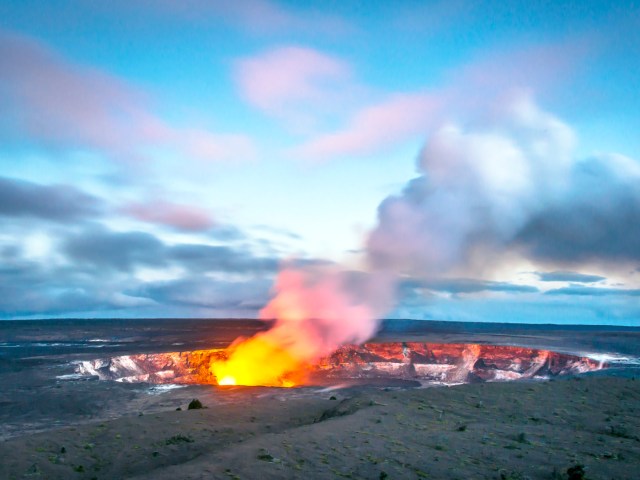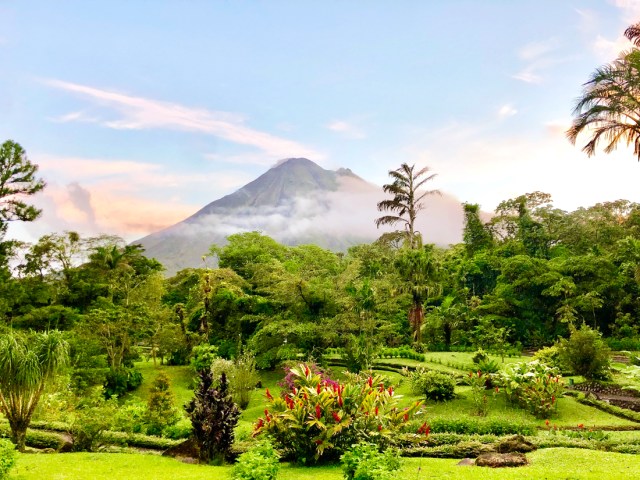Found on every continent, volcanoes are responsible for some 80% of the surface of the Earth. Over millions of years of eruptions, they have created some of the planet’s most stunning natural landscapes. While around 1,500 are considered active today, others have lay dormant for thousands of years. From one of the world’s most active volcanoes to North America’s tallest volcano, here are five of the most stunning volcanoes on the planet that you can safely visit.
Kīlauea – Hawaii

In many parts of Hawai’i Volcanoes National Park, you might feel like you’re on another planet. Witness: hot molten lava snaking its way, bubbling and glowing, across a rugged, Martian-like landscape before falling over steep cliffs and meeting the Pacific Ocean in an explosion of steam. The park was established in 1916 around one of the world’s most active volcanoes, Kīlauea, which has been in continuous eruption since 1983, and neighboring Mauna Loa, which last erupted in 1984. When measured from the Pacific Ocean floor, Mauna Loa is the largest volcanic mass on Earth.
The similarity to Mars is no coincidence: Kīlauea’s lava fields contain vast amounts of basalt, as does the surface of the Red Planet. In fact, NASA has spent years in the national park to simulate conditions on Mars. But for earthlings, the park — a UNESCO World Heritage Site — offers 150 miles of hiking trails through incredibly varied topography, from cliffs to scalded deserts and rainforests. Just be sure to take care in such a sacred place to traditional Hawaiian culture: Legend says that Pele — the goddess of volcanoes and creator of the islands — once resided in Halemaʻumaʻu crater at Kīlauea’s summit.
Arenal – Costa Rica

If there was ever a reason to leave Costa Rica’s gorgeous coastline, it might just be Arenal. Located within the 30,000-acre jungle wilderness of Arenal Volcano National Park, Arenal is a 5,400-foot stratovolcano, magnificently conical and symmetrical — pretty much a photographer’s dream.
After admiring Arenal’s stunning vistas, visitors can hike the park’s lava fields and jungles, swim or fish in pristine waters, and scope out a laundry list of bird and butterfly species. While you can climb the volcano, consider hiking the neighboring Mount Chato instead. The climb is strenuous, but you’ll enjoy unparalleled views of the majestic Arenal and you’ll be able to swim in a crystalline crater lake in the shadows of the volcano’s soaring peak. After your climb, check out the neighboring town of Tabacón — decimated by the volcano’s last major eruption in 1968, it has since been reinvented as a spa destination, where visitors can rest and relax with volcanically-heated mineral water dips and treatments.
The Pitons – St. Lucia

St. Lucia’s national motto is, “The land, the people, the light,” and all three converge at the island state’s most beloved natural wonder. Basking high above the Caribbean Sea, the Pitons are plugs of two dormant volcanoes that took shape between 200,000 and 300,000 years ago. The Arawaks — early citizens of St. Lucia — worshipped the peaks as Atebyra, the god of food and fertility, and Yokahu, the god of fire, thunder, and rain. The twin peaks — 2,460-foot Petit Piton and 2,619-foot Gros Piton — form a UNESCO World Heritage Site designated in 2004.
There’s no missing the Pitons — from cruise ships, from helicopter windows, or even when emerging from snorkeling sessions — but one of the best ways to experience them is to climb them. In fact, climbing excursions on Gros Piton are encouraged, since the mountain has marked trails. The 3.2-mile round-trip hike takes between 6 and 12 hours, and tour guides are ready to help you make the jungle ascent so you can sign the summit register.
Mount Teide – Canary Islands, Spain

Though it’s considered Spain’s highest peak, Mount Teide is exponentially closer to Africa than to Europe. Positioned about 200 miles off the southwest coast of Morocco and 800 southwest of Spain, this volcano — one of the tallest in the world — rises almost 12,200 feet from the heart of Tenerife in the Canary Islands (a Spanish territory). The surrounding national park, also a UNESCO World Heritage Site, blends volcanic boulders with petrified lava rivers, steaming vents, and gaping craters, among other surreal elements. But one of the most otherworldly natural attractions is in the air: Every so often, a so-called “sea of clouds” moves in, enshrouding the peak in an extra layer of drama.
You can hike or drive your way through the park, take a cable car to the top of the volcano, and even spend the night in one of two onsite lodging options — a convenient way to check out the park’s famously starry skies. By day, however, you shouldn’t miss the Teide Observatory, one of the largest solar observatories on Earth.
Pico de Orizaba – Mexico

In the Nahuatl language, Pico de Orizaba is known as Citlaltépetl, which translates to “Star Mountain” — an apt descriptor for North America’s tallest volcano. The 18,491-foot snow-capped peak straddles the border of the Mexican states Puebla and Veracruz, and though it’s dormant, it’s not considered extinct. The last time it erupted was in 1846. Along with Mount Kilimanjaro in Africa, it’s one of the world’s most topographically pronounced volcanic peaks. Its sheer size is stunning and even makes it visible to boats entering the port of Veracruz almost 70 miles away.
Pico de Orizaba is popular among serious mountain climbers from all over the world, most of whom start their trek at the nearby town of Tlachichuca. Hundreds of experienced hikers make the journey to its glacier-topped summit each year — mostly during the winter near Christmas, México’s dry season. Altitude and weather can be extreme, and proper gear is a must. You’ll also start your journey early — typically at 2 or 3 a.m. — both to enjoy the dramatic shadows of the peak as the sun rises, and to avoid the dense fog that typically shrouds the peak in late afternoon.
More from our network
Daily Passport is part of Inbox Studio, which publishes content that uplifts, informs, and inspires.
















